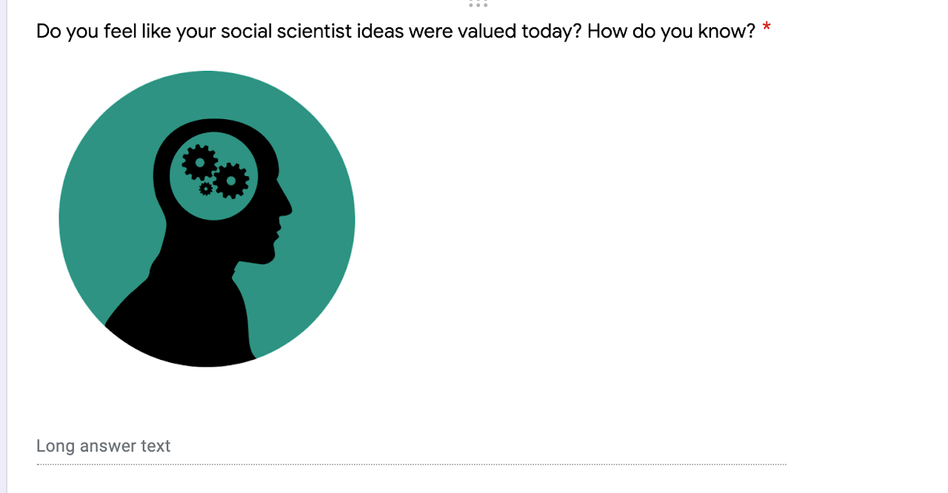reclaim your identity | reclama tu identidad
Cycle two lens: Universal Design for Learning
The three core principles
-
Multiple Means of Engagement
-
Multiple Means of Representation
-
Multiple Means of Action or Expression
The research question
How can we empower students' voices and choice in demonstrating their critical understanding of redlining?
Our wonderings
-
How can we allow students to carry the cognitive load
-
How can we engage in anti-deficit thinking when designing learning activities?

Lesson Study Winter 2021
Cycle Two
Meet The Team
Theory of Action
IF we as teachers give students specific learning goals and empower students as designers of their own learning (through Build, Act, Write, Draw)
THEN students will be able to use their unique assets to meet learning objectives
RESULTING in greater critical consciousness
Goals
Equity goal
-
Students will tap into their assets to assess and display their knowledge about redlining and use critical consciousness to make connections to themselves and the world around them.
Content goal
-
Students will understand the impact of redlining in the U.S. and the implications of environmental racism.
Focus students
Focus student one
-
A wonderful self-advocate in their first year as a part of the High Tech Hight system. Is a 'Star Wars' fan, is friendly and likes to have their camera on during class. Desires to improve academically and is an emergent bilingual student.
-
Strength: extremely social and talkative.
-
Need: the ability to talk as they think and work with a team.
Focus student two
-
Is a fan of music and K-Pop, is socially aware and empathetic. Wealth of funds of knowledge and lived experience is a benefit when they share in class.
-
Strength: astute researcher.
-
Need: the ability to have clear directions and understanding how their individual role contributes to the group.
Focus student three
-
This student enjoys video games and is not talkative, struggles with organization and motivation but has strong family bonds.
-
Strength: socially aware and enthusiastic about social movements.
-
Need: the ability to see the value in work affecting life outside of school
The lesson
Multiple Means of Action or Expression
-
Students received the opportunity to access academic vocabulary and higher-order thinking in a way that featured their assets and interests.
Multiple Means of Representation
-
These were two out of three videos that were shown to provide an example of environmental racism. These videos allowed students to receive information in an alternate format after initially having a conversation and writing about environmental racism

Examples of student work
Classroom feedback
Reflection
During this lesson study our team’s goal was to incite student thinking on the topic of redlining. We wanted our students to be intentional about thinking of the consequences redlining and segregation have on the communities in close proximity to pollution, and the correlation of worsening health conditions in these communities. Some of our team’s aspirations was also to construct a lesson in which students would have the capacity to choose how challenged they wanted to be. Additionally we thought that our lesson should revolve around prior knowledge, experience and research.
To employ our aim of sparking critical consciousness in our students we had to take into consideration our practices as educators. We were able to reflect on our best practices and what areas we needed to focus on to achieve growth. I believe that our team was able to build a lesson in which the students could carry the cognitive load while engaging in meaningful and relevant work revolving around redlining and environmental racism.
Due to the ongoing pandemic and the delivery of the lesson via distance-learning, our team assessed the level of engagement of the topic via participation (turning cameras on, chat response, reactions) through the student work showcased on jamboard, and the exit ticket. Our team provided a variety of learning opportunities with asset-based approaches and encouraged students to demonstrate their knowledge. This approach allowed student assets to be highlighted which resulted in high levels of engagement revolving around environmental racism.
One of the ways we engaged our students was by providing examples that highlighted people their age so that they could picture themselves in the content. Some of the evidence for this came when students pointed out the young activists’ race, age, and gender that reflected a majority of the classroom populations’ cultural backgrounds. Additionally our team highlighted several aspects of our lesson.
Beginning
-
Students were able to frame the lesson with brave space norms. Actively working to be anti-racist, anti-homophobic, anti-classist, and anti-sexist.
-
Higher Order Thinking- Students were polled at the beginning of the lesson and at the end of the lesson and asked to compare their views and thoughts to
Middle
-
Students were given academic vocabulary and asked to reflect and provide examples and definitions for words like: Redlining, Environmental Justice, Social Justice, Activism, Pollution, Equity and Equality.
End
-
Students were provided an exit ticket in which they had the opportunity to compare their beliefs and knowledge about redlining from before the lesson and after the lesson.
In the future I hope to craft similar lessons in which we are able to invite students to see the importance of a subject and see themselves in the content. The collaborative experience greatly expanded my understanding of several areas I still struggle with, and allowed for growth. I hope to create meaningful and thoughtful work that students can build alongside me, providing intentional feedback and allowing for multiple means of demonstrating learning. This lesson cycle really pushed the boundaries of what we can accomplish and I would like to keep the same pace for our last cycle of lesson study.
.jpg)














